+ Open data
Open data
- Basic information
Basic information
| Entry | Database: PDB / ID: 4ztd | ||||||
|---|---|---|---|---|---|---|---|
| Title | Crystal Structure of Human PCNA in complex with a TRAIP peptide | ||||||
 Components Components |
| ||||||
 Keywords Keywords |  REPLICATION / REPLICATION /  PCNA / TRAIP / PCNA / TRAIP /  complex complex | ||||||
| Function / homology |  Function and homology information Function and homology informationpositive regulation of deoxyribonuclease activity / dinucleotide insertion or deletion binding / PCNA-p21 complex / mitotic telomere maintenance via semi-conservative replication / purine-specific mismatch base pair DNA N-glycosylase activity / positive regulation of DNA-directed DNA polymerase activity / MutLalpha complex binding /  nuclear lamina / Polymerase switching / Telomere C-strand (Lagging Strand) Synthesis ...positive regulation of deoxyribonuclease activity / dinucleotide insertion or deletion binding / PCNA-p21 complex / mitotic telomere maintenance via semi-conservative replication / purine-specific mismatch base pair DNA N-glycosylase activity / positive regulation of DNA-directed DNA polymerase activity / MutLalpha complex binding / nuclear lamina / Polymerase switching / Telomere C-strand (Lagging Strand) Synthesis ...positive regulation of deoxyribonuclease activity / dinucleotide insertion or deletion binding / PCNA-p21 complex / mitotic telomere maintenance via semi-conservative replication / purine-specific mismatch base pair DNA N-glycosylase activity / positive regulation of DNA-directed DNA polymerase activity / MutLalpha complex binding /  nuclear lamina / Polymerase switching / Telomere C-strand (Lagging Strand) Synthesis / Processive synthesis on the lagging strand / nuclear lamina / Polymerase switching / Telomere C-strand (Lagging Strand) Synthesis / Processive synthesis on the lagging strand /  PCNA complex / Processive synthesis on the C-strand of the telomere / Removal of the Flap Intermediate / Mismatch repair (MMR) directed by MSH2:MSH3 (MutSbeta) / Mismatch repair (MMR) directed by MSH2:MSH6 (MutSalpha) / Polymerase switching on the C-strand of the telomere / Transcription of E2F targets under negative control by DREAM complex / negative regulation of interferon-beta production / Removal of the Flap Intermediate from the C-strand / PCNA complex / Processive synthesis on the C-strand of the telomere / Removal of the Flap Intermediate / Mismatch repair (MMR) directed by MSH2:MSH3 (MutSbeta) / Mismatch repair (MMR) directed by MSH2:MSH6 (MutSalpha) / Polymerase switching on the C-strand of the telomere / Transcription of E2F targets under negative control by DREAM complex / negative regulation of interferon-beta production / Removal of the Flap Intermediate from the C-strand /  replisome / response to L-glutamate / replisome / response to L-glutamate /  histone acetyltransferase binding / leading strand elongation / DNA polymerase processivity factor activity / replication fork processing / G1/S-Specific Transcription / response to dexamethasone / negative regulation of NF-kappaB transcription factor activity / nuclear replication fork / site of DNA damage / SUMOylation of DNA replication proteins / histone acetyltransferase binding / leading strand elongation / DNA polymerase processivity factor activity / replication fork processing / G1/S-Specific Transcription / response to dexamethasone / negative regulation of NF-kappaB transcription factor activity / nuclear replication fork / site of DNA damage / SUMOylation of DNA replication proteins /  estrous cycle / PCNA-Dependent Long Patch Base Excision Repair / estrous cycle / PCNA-Dependent Long Patch Base Excision Repair /  mismatch repair / cyclin-dependent protein kinase holoenzyme complex / negative regulation of tumor necrosis factor-mediated signaling pathway / mismatch repair / cyclin-dependent protein kinase holoenzyme complex / negative regulation of tumor necrosis factor-mediated signaling pathway /  translesion synthesis / positive regulation of DNA replication / response to cadmium ion / translesion synthesis / positive regulation of DNA replication / response to cadmium ion /  DNA polymerase binding / DNA polymerase binding /  base-excision repair, gap-filling / positive regulation of DNA repair / epithelial cell differentiation / Translesion synthesis by REV1 / Translesion synthesis by POLK / Translesion synthesis by POLI / Gap-filling DNA repair synthesis and ligation in GG-NER / TP53 Regulates Transcription of Genes Involved in G2 Cell Cycle Arrest / base-excision repair, gap-filling / positive regulation of DNA repair / epithelial cell differentiation / Translesion synthesis by REV1 / Translesion synthesis by POLK / Translesion synthesis by POLI / Gap-filling DNA repair synthesis and ligation in GG-NER / TP53 Regulates Transcription of Genes Involved in G2 Cell Cycle Arrest /  replication fork / male germ cell nucleus / replication fork / male germ cell nucleus /  liver regeneration / nuclear estrogen receptor binding / Recognition of DNA damage by PCNA-containing replication complex / Termination of translesion DNA synthesis / Translesion Synthesis by POLH / RING-type E3 ubiquitin transferase / HDR through Homologous Recombination (HRR) / Dual Incision in GG-NER / liver regeneration / nuclear estrogen receptor binding / Recognition of DNA damage by PCNA-containing replication complex / Termination of translesion DNA synthesis / Translesion Synthesis by POLH / RING-type E3 ubiquitin transferase / HDR through Homologous Recombination (HRR) / Dual Incision in GG-NER /  receptor tyrosine kinase binding / cellular response to hydrogen peroxide / Dual incision in TC-NER / Gap-filling DNA repair synthesis and ligation in TC-NER / ubiquitin-protein transferase activity / cellular response to UV / receptor tyrosine kinase binding / cellular response to hydrogen peroxide / Dual incision in TC-NER / Gap-filling DNA repair synthesis and ligation in TC-NER / ubiquitin-protein transferase activity / cellular response to UV /  ubiquitin protein ligase activity / cellular response to xenobiotic stimulus / Antigen processing: Ubiquitination & Proteasome degradation / response to estradiol / E3 ubiquitin ligases ubiquitinate target proteins / ubiquitin protein ligase activity / cellular response to xenobiotic stimulus / Antigen processing: Ubiquitination & Proteasome degradation / response to estradiol / E3 ubiquitin ligases ubiquitinate target proteins /  heart development / damaged DNA binding / heart development / damaged DNA binding /  chromosome, telomeric region / protein ubiquitination / chromosome, telomeric region / protein ubiquitination /  nuclear body / nuclear body /  centrosome / apoptotic process / DNA damage response / centrosome / apoptotic process / DNA damage response /  chromatin binding / chromatin binding /  chromatin / protein-containing complex binding / chromatin / protein-containing complex binding /  nucleolus / perinuclear region of cytoplasm / negative regulation of transcription by RNA polymerase II / nucleolus / perinuclear region of cytoplasm / negative regulation of transcription by RNA polymerase II /  enzyme binding / enzyme binding /  signal transduction / extracellular exosome / signal transduction / extracellular exosome /  nucleoplasm / identical protein binding / nucleoplasm / identical protein binding /  metal ion binding / metal ion binding /  nucleus nucleusSimilarity search - Function | ||||||
| Biological species |   Homo sapiens (human) Homo sapiens (human) | ||||||
| Method |  X-RAY DIFFRACTION / X-RAY DIFFRACTION /  SYNCHROTRON / SYNCHROTRON /  MOLECULAR REPLACEMENT / Resolution: 2.199 Å MOLECULAR REPLACEMENT / Resolution: 2.199 Å | ||||||
 Authors Authors | Montoya, G. / Mortuza, G.B. / Blanco, F.J. / Ibanez de Opakua, A. | ||||||
 Citation Citation |  Journal: J.Cell Biol. / Year: 2016 Journal: J.Cell Biol. / Year: 2016Title: TRAIP is a PCNA-binding ubiquitin ligase that protects genome stability after replication stress. Authors: Hoffmann, S. / Smedegaard, S. / Nakamura, K. / Mortuza, G.B. / Raschle, M. / Ibanez de Opakua, A. / Oka, Y. / Feng, Y. / Blanco, F.J. / Mann, M. / Montoya, G. / Groth, A. / Bekker-Jensen, S. / Mailand, N. #1:  Journal: Nat Commun / Year: 2015 Journal: Nat Commun / Year: 2015Title: Structure of p15(PAF)-PCNA complex and implications for clamp sliding during DNA replication and repair. Authors: De Biasio, A. / de Opakua, A.I. / Mortuza, G.B. / Molina, R. / Cordeiro, T.N. / Castillo, F. / Villate, M. / Merino, N. / Delgado, S. / Gil-Carton, D. / Luque, I. / Diercks, T. / Bernado, P. ...Authors: De Biasio, A. / de Opakua, A.I. / Mortuza, G.B. / Molina, R. / Cordeiro, T.N. / Castillo, F. / Villate, M. / Merino, N. / Delgado, S. / Gil-Carton, D. / Luque, I. / Diercks, T. / Bernado, P. / Montoya, G. / Blanco, F.J. | ||||||
| History |
|
- Structure visualization
Structure visualization
| Structure viewer | Molecule:  Molmil Molmil Jmol/JSmol Jmol/JSmol |
|---|
- Downloads & links
Downloads & links
- Download
Download
| PDBx/mmCIF format |  4ztd.cif.gz 4ztd.cif.gz | 311.2 KB | Display |  PDBx/mmCIF format PDBx/mmCIF format |
|---|---|---|---|---|
| PDB format |  pdb4ztd.ent.gz pdb4ztd.ent.gz | 254 KB | Display |  PDB format PDB format |
| PDBx/mmJSON format |  4ztd.json.gz 4ztd.json.gz | Tree view |  PDBx/mmJSON format PDBx/mmJSON format | |
| Others |  Other downloads Other downloads |
-Validation report
| Arichive directory |  https://data.pdbj.org/pub/pdb/validation_reports/zt/4ztd https://data.pdbj.org/pub/pdb/validation_reports/zt/4ztd ftp://data.pdbj.org/pub/pdb/validation_reports/zt/4ztd ftp://data.pdbj.org/pub/pdb/validation_reports/zt/4ztd | HTTPS FTP |
|---|
-Related structure data
| Related structure data |  4d2gS S: Starting model for refinement |
|---|---|
| Similar structure data |
- Links
Links
- Assembly
Assembly
| Deposited unit | 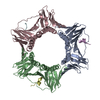
| ||||||||
|---|---|---|---|---|---|---|---|---|---|
| 1 |
| ||||||||
| Unit cell |
|
- Components
Components
| #1: Protein |  / PCNA / Cyclin / PCNA / CyclinMass: 27904.836 Da / Num. of mol.: 3 / Fragment: UNP residues 2-254 Source method: isolated from a genetically manipulated source Source: (gene. exp.)   Homo sapiens (human) / Gene: PCNA / Production host: Homo sapiens (human) / Gene: PCNA / Production host:   Escherichia coli (E. coli) / References: UniProt: P12004 Escherichia coli (E. coli) / References: UniProt: P12004#2: Protein/peptide | Mass: 1427.622 Da / Num. of mol.: 2 / Source method: obtained synthetically / Source: (synth.)   Homo sapiens (human) / References: UniProt: Q9BWF2*PLUS Homo sapiens (human) / References: UniProt: Q9BWF2*PLUS#3: Protein/peptide | | Mass: 345.352 Da / Num. of mol.: 1 / Source method: obtained synthetically / Source: (synth.)   Homo sapiens (human) Homo sapiens (human)#4: Water | ChemComp-HOH / |  Water Water |
|---|
-Experimental details
-Experiment
| Experiment | Method:  X-RAY DIFFRACTION / Number of used crystals: 1 X-RAY DIFFRACTION / Number of used crystals: 1 |
|---|
- Sample preparation
Sample preparation
| Crystal | Density Matthews: 2.49 Å3/Da / Density % sol: 50.64 % |
|---|---|
Crystal grow | Temperature: 291 K / Method: vapor diffusion, hanging drop Details: 16% PEG 6K in 0.1mM magnesium acetate, MES buffer pH 6.5 PH range: 6.5 |
-Data collection
| Diffraction | Mean temperature: 100 K |
|---|---|
| Diffraction source | Source:  SYNCHROTRON / Site: SYNCHROTRON / Site:  SLS SLS  / Beamline: X06SA / Wavelength: 1 Å / Beamline: X06SA / Wavelength: 1 Å |
| Detector | Type: PSI PILATUS 6M / Detector: PIXEL / Date: Apr 18, 2015 |
| Radiation | Protocol: SINGLE WAVELENGTH / Monochromatic (M) / Laue (L): M / Scattering type: x-ray |
| Radiation wavelength | Wavelength : 1 Å / Relative weight: 1 : 1 Å / Relative weight: 1 |
| Reflection twin | Operator: h,-h-k,-l / Fraction: 0.11 |
| Reflection | Resolution: 2.199→42.749 Å / Num. obs: 42654 / % possible obs: 99.17 % / Redundancy: 8 % / Rmerge(I) obs: 0.06399 / Net I/σ(I): 22.17 |
| Reflection shell | Resolution: 2.199→2.2519 Å / Rmerge(I) obs: 0.7153 |
- Processing
Processing
| Software |
| ||||||||||||||||||||||||||||||||||||||||||||||||||||||||||||||||||||||||||||||||||||||||||||||||||||||||||||||||
|---|---|---|---|---|---|---|---|---|---|---|---|---|---|---|---|---|---|---|---|---|---|---|---|---|---|---|---|---|---|---|---|---|---|---|---|---|---|---|---|---|---|---|---|---|---|---|---|---|---|---|---|---|---|---|---|---|---|---|---|---|---|---|---|---|---|---|---|---|---|---|---|---|---|---|---|---|---|---|---|---|---|---|---|---|---|---|---|---|---|---|---|---|---|---|---|---|---|---|---|---|---|---|---|---|---|---|---|---|---|---|---|---|---|
| Refinement | Method to determine structure : :  MOLECULAR REPLACEMENT MOLECULAR REPLACEMENTStarting model: 4D2G Resolution: 2.199→42.749 Å / Cross valid method: FREE R-VALUE / σ(F): 1.31 / Phase error: 28.5 / Stereochemistry target values: TWIN_LSQ_F
| ||||||||||||||||||||||||||||||||||||||||||||||||||||||||||||||||||||||||||||||||||||||||||||||||||||||||||||||||
| Solvent computation | Shrinkage radii: 0.9 Å / VDW probe radii: 1.11 Å / Solvent model: FLAT BULK SOLVENT MODEL | ||||||||||||||||||||||||||||||||||||||||||||||||||||||||||||||||||||||||||||||||||||||||||||||||||||||||||||||||
| Displacement parameters | Biso max: 132.61 Å2 / Biso mean: 56.6074 Å2 / Biso min: 20 Å2 | ||||||||||||||||||||||||||||||||||||||||||||||||||||||||||||||||||||||||||||||||||||||||||||||||||||||||||||||||
| Refinement step | Cycle: final / Resolution: 2.199→42.749 Å
| ||||||||||||||||||||||||||||||||||||||||||||||||||||||||||||||||||||||||||||||||||||||||||||||||||||||||||||||||
| Refine LS restraints |
| ||||||||||||||||||||||||||||||||||||||||||||||||||||||||||||||||||||||||||||||||||||||||||||||||||||||||||||||||
| LS refinement shell | Refine-ID: X-RAY DIFFRACTION / Total num. of bins used: 15
|
 Movie
Movie Controller
Controller



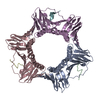
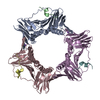
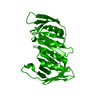


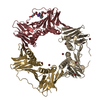
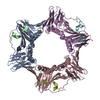


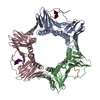
 PDBj
PDBj


















